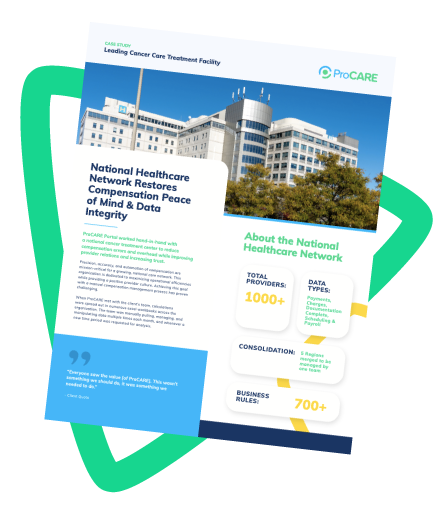FREQUENTLY ASKED QUESTIONS
Managing complex compensation plans is…complex.
Aligning with the right partner is key to success. Before we dive in, let’s make sure we’re a good fit! Here we answered some of the most common questions we get during initial conversations that help us determine if our solution is the best-fit option for your organization.
Implementation
What is the typical implementation timeline?
Plan for a typical implementation to take about six months. That said, we can deliver elements of the platform before the end of the process, controlling the go-live timetable with scope decisions and incremental deliveries. The implementation process includes five distinct phases including Discover, Design, Configure, Test and Deploy. Read more about our implementation methodology and process here.
Who sets up the ProCARE system?
Implementation is full service so the ProCARE team will configure all your business rules and data integration. Ongoing clients have full visibility and control of those configurations. ProCARE is always available for support of these confirmation with our best in class Customer Success and Support team. Client teams are able to self service future changes without additional build.
In what format does ProCARE need data to be provided?
Nearly all data can be integrated through the data source directly and automatically with the ProCARE Data Transfer Utility (DTU). The DTU is is a robust data integration tool that handles all ETL type conversions and formatting and links to our rules processing to enable preprocessing where necessary to add additional data or linkages to give the rule engine the components it needs and our clients’ visibility and much fewer hassles to worry about.
This includes all types of data including organizational, transaction, supporting tables, users, roles, access levels, etc. In some cases due to the nature of compensation manual uploads are necessary, in which case ProCARE provides the exact templates needed to successfully import data in the most streamlined manner possible. Information for supporting tables can be accessed and changed in the platform user interface or with template uploads.
How does ProCARE consider historical data prior to implementation?
If plans change, for example with RVU changes, you want meaningful comparisons. We generally load the prior fiscal year of raw data for UAT. Since it is typical to find many errors in the past calculations, and because current processes are typically not tight enough to have all adjustments and one-off payments documented, we make adjustments to make the prior fiscal year match what was paid.
We can aggregate and load key result names for historical views for as far back as you would like including TCC, RVUs, Charges, Quality Attainment Scores, etc.
Clients
What types of companies do you work with?
We work primarily with enterprise-level clients across the country, exclusively providing full compensation automation. Our clients range in size from 250-3000+ providers and include health systems, hospital and medical groups, and specialty provider networks. While all of our agreements have non-disclosure language, we do have enterprise references available to share with prospects.
What is the most challenging plan you manage?
Working with enterprise clients, ProCARE was built for complex models and specifically designed to meet the ever changing move to value in the industry. Complexities typically arise from contract year logic that does not snap to a fiscal or calendar year, contracts start mid-period, so proration logic is necessary, and/or there are varying payment frequencies and true-up logic. Complex data transformation and linkages may need to occur from a large variety of source data throughout the organization which is all automated.
Additional complexities may include guarantees for specific timeframes with upside logic, logic to prorate rates and targets based on FTE or leave, and various series of logic to feed payments vs accruals. In short, the complexities may be endless but our rules engine can automate it all and you’ll have visibility and control over each calculation and output.
Automation & Management
How does ProCARE handle complex business rules compared to other vendors?
Any math equation is automated in ProCARE, with our clients having visibility into each of the steps. This is done within the platform and possible due to the sophisticated framework of the ProCARE. The framework enables ProCARE to be scalable to all our clients business needs without custom coding. Exceptions are managed easily within the platform.
Why is the ProCARE framework and methodology more scalable than other vendors?
ProCARE was started exclusively as a comp automation solution for healthcare rooted in comp automation experience for other industries and deep healthcare knowledge. ProCARE is custom configured but not custom built. Custom coding is not scalable as vendors with this strategy are not able to show the visibility to your unique calculations. Any changes or exceptions must be hard coded by those vendor whereas in ProCARE those changes are made automatically based on the data or by adding or adjusting values in supporting tables in ProCARE. Calculations logic is created and maintained in the platform and visible by the client team.You can interact with any element as needed to create exceptions, manage targets, change thresholds or more.
In systems without a robust framework validation and transparency become big issues with sets you up for mistakes. Custom coding becomes very hard to evolve to new models without repeating the implementation process. Perhaps the biggest drawback to custom coded solutions is issues they will present in the months and years down the road when new functionalities and improvements are attempted to be added.
What level of customization is available - is the platform unique to each client?
ProCARE serves as end-to-end comp automation for 12k+ providers across the nation. While there are similarities in models, the details of the methodology, data process, exceptions, timing needs, and business rules are all different. The overlap in structural components – such as organizational hierarchy, comp processing workflows, data needs, use of core systems, and management of changing exceptions – is the basis for the ProCARE rules engine, configured to manage and adapt to all complexities.
We automate first, optimize second. Automation is made possible by our data integration tool (Data Transfer Utility) – and starts with the source data from across the organization which updates and manages event data and organizational hierarchy.
This starts with automation of source data from across the organization, which not only populate what we call event data (hours, RVUs, collections, quality, population health, etc.) but also update and manage the organizational hierarchy (new providers, new versions, new groups, etc.). This done by our Data Transfer Utility (DTU) which is a robust data integration tool that handles all ETL type conversions and formatting and links to our rules processing to enable preprocessing where necessary to add additional data or linkages to give the rule engine the components it needs and our clients’ visibility and much fewer hassles to worry about.
Next, we layer on top a rules engine with many phases that link to those automated data sources to automate any calculation and route that to other calculations or other systems systematically.
When raw data comes in, that is the start of the rules automation as data is appropriately credited to individuals and or groups, comp dates are assigned based on payroll calendars/preferences, and exception logic adds adjustments or additional columns of data to be used by other rules.
The rules engine is built around and leverages a structure that manages the organization details (calendars, periods, organization hierarchy, access, etc.). This allows rules to be applied at various levels of the org hierarchy and timing (e.g., 12 month rolling, payments 3 times a year, payments in arrears, etc.).
The system is configured in the UI based on the unique needs of our clients. During implementation, we set up the automation and supporting tables so end users can manage and have visibility to ongoing exceptions logic and see visibility to data that is versioned off with the appropriate dates needed for the calculation. Ongoing our support team is always available, but our clients can function very well on their own as the system is configured to support them and helps drive the monthly processing schedule. Our admin users interact as needed to make overrides or adjustments in instances where business rules are modified as an exception.
In the automated onboarding process, is there a manual approval or review?
We work to automate everything we can through the data automation strategy and logic. What we cannot get from a source system – or derive through lookups and logic – we batch and allow admins to supplement the existing onboarding automation with a template that is loaded, goes through automation, and updates provider records, tables, etc., to facilitate the processing needs.
What upkeep is required by clients to maintain data integrations?
Our deep integrations allow for most data loads to occur automatically, with data available in ProCARE within the same day as loaded into a third party source. Clients simply need to monitor the logs to ensure there were no issues with the data, and follow a simple workflow to reload any errored records – which is made easier by our Data Transfer Utility which is configured to alert team members of any important errors. Errors typically come from the data sources themselves and are most often due to data formatting or missing information. This process allows you to rest easy knowing the data you expected to load was validated and loaded.
How does ProCARE manage logging data that is more manual in nature?
Manual data that is more lagging in nature, such as ticker sheets, adjustments, one-offs, are still loaded automatically with our process mapping key fields which strips out as much redundancy as possible. For example, clients may put through manual RVU files with only three columns of data from outside clinics but during the lookup process all key attributes for the calculation are mapped in from the reference tables automated from source systems. Occasionally there may be separate SOWs to build out new exceptions, but many of our clients are self-serving in this aspect.
How does ProCARE handle retro processing or historical changes?
ProCARE helps tremendously in reducing lags in correcting assignments that lead to issues down the road. We can handle retro changes in many ways, typically through YTD true-ups. In the case of missing a contract change from months ago, for example, the comp team is able to log adjustments to the YTD calculations for all relevant touchpoints, scores, thresholds, topline figures and various dollar amounts. No longer will you find yourself trying to put a square peg in a round hole each month to keep up with adjustments from throughout the year.
What is the payment approval process?
In ProCARE, there are several approval-type workflows, including publishing data and approving payments. A series of approvals can be set up before the payfile is sent to payroll for payment files. Admins kick off jobs that allow the processing of data for specific needs, including reports. When data is published, you can send an HTML version of reports or your settings can be enabled to notify providers to access their report online. With time tracking events, specific events that are loaded by providers are approved by comp admins so they can be used in processing.
Reporting
What does a Provider Comp Report look like?
Is the report static or dynamic, pushed or pulled?, At what level of detail can a provider see?
ProCARE provides dashboard, detail, and results reporting that are role and data level enabled and accessible in the UI or through email. Dashboards are customizable both in creation and view and can output virtually any value you desire, drilling into supporting data in real-time. Reports are dynamic, as they are driven by the data that the rules engine creates, but the view is static.
Dashboards can be set to show at the specialty, plan, group, or provider level and are organized in tabs to facilitate different access and slices of time/groups. You can link from the dashboards to detailed result-level data and raw events at various phases (i.e. measure or payment).
Example: Rules output results around a provider’s RVU benchmark. Another result then looks at the benchmark number and determines who is under a certain level. A user could then download a list of those meeting this criteria or a list of all providers RVU benchmark.
Our Solution
How is price determined for the ProCARE product?
We are honest and transparent about our pricing, and are typically sharing an estimated cost with you on our first Introductory Call. There are two pricing components – a one time implementation and monthly user license fees. Monthly user license fees are straightforward, with the per user license fee reducing as you increase the number of users and enter the higher user tiers.
Our pricing methodology for implementation is inclusive of four primary factors: complexity, the number of compensation plans, data source integrations and future state change. The complexity depends on factors such as proration requirements and XYZ. The number of compensation plans is often less than what our clients originally think they will be – with most of our clients averaging 3-5 plans. Data source integrations would include things such as payroll, HR, EMR systems, etc. Future state changes such as adding comp plans, acquiring practices, etc are typically determined by your organization’s roadmap and are much more scalable and cost efficient than competing solutions due to our framework.
How do you manage PHI?
By controlling detail columns and views, we’re able to control what data is available and who has access to it. We have full auditing control within the platform, encrypt all data and can turn off the ability to download detail data. Not to brag, but we pass infosec reviews with flying colors.
Uplevel your compensation management and improve retention, productivity and performance.
Get started today with an Introductory Call




